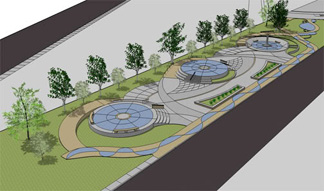 Parents, teachers, administrators and even students were in a mood to celebrate the beginning of the new school year. Students in the Los Angeles Unified School District not only started their 2010 summer break a week early, they also ended it a week late. School traditionally starts right after the Labor Day holiday. But this year, budget cuts and furloughs pushed back the first day of school until September 13th.
Parents, teachers, administrators and even students were in a mood to celebrate the beginning of the new school year. Students in the Los Angeles Unified School District not only started their 2010 summer break a week early, they also ended it a week late. School traditionally starts right after the Labor Day holiday. But this year, budget cuts and furloughs pushed back the first day of school until September 13th.
Los Angeles Mayor Antonio Villaraigosa kicked off the school year by applauding gains in Academic Performance Index (API) scores, which were released Monday morning. One of the school that saw an increase in its API scores was Santee High School in South Los Angeles. The mayor went there for a morning pep rally. Click to hear about his visit and the pep rally in a story by Ruth Frantz of Annenberg Radio News.
The Academic Performance Index charts the progress made by public school students throughout California. Schools are rated on a scale of 200 to 1000, with a state target score of 800. In the Los Angeles Unified School District, 28 more schoos got an API score of at least 800 this year, up to a total of 173. And, more than half of all LAUSD schools have an API score of 750 or above this year.
 Several schools in South Los Angeles recorded increases in their API scores. For the second year in a row, 99th Street Elementary School in Watts has raised its API, this year by 52 points. In addition to Santee High School, Markham Middle School in Watts recorded growth. All three of those schools are operated by the Partnership for Los Angeles Schools, a collaboration between the City of Los Angeles and LAUSD to turnaround the city’s lowest performing schools.
Several schools in South Los Angeles recorded increases in their API scores. For the second year in a row, 99th Street Elementary School in Watts has raised its API, this year by 52 points. In addition to Santee High School, Markham Middle School in Watts recorded growth. All three of those schools are operated by the Partnership for Los Angeles Schools, a collaboration between the City of Los Angeles and LAUSD to turnaround the city’s lowest performing schools.
In addition, the ICEF (Inner City Education Foundation) Public Schools, which operates a network of 15 public charter schools in South L.A. announced today that six of their schools topped the state’s target score of 800. ICEF serves a student population that is 89 percent African-American.
According to a news release put out by ICEF:
“At the elementary level, 4 out of 5 schools exceeded 800, with ICEF Inglewood Elementary scoring a 768 in just its first year in operation. ICEF’s View Park Prep and Frederick Douglass elementary schools are rapidly closing in on 900 points with scores of 891 and 877 respectively … The results show that the ICEF academic model works system-wide and is replicable. The first API score for Frederick Douglass Elementary, which opened last year, was an impressive 877, in a school with a 94 percent African-American and 74 percent free-and-reduced lunch student population.”










 WATTS- The Watts Towers rise above the South Los Angeles neighborhood, a testament to the ambition of an Italian immigrant who called Watts his home for decades. But in the realities of a recession, the nearly 90-year-old icons have seen their budget cut, a blow to the 17 fragile structures in constant need of maintenance.
WATTS- The Watts Towers rise above the South Los Angeles neighborhood, a testament to the ambition of an Italian immigrant who called Watts his home for decades. But in the realities of a recession, the nearly 90-year-old icons have seen their budget cut, a blow to the 17 fragile structures in constant need of maintenance.




